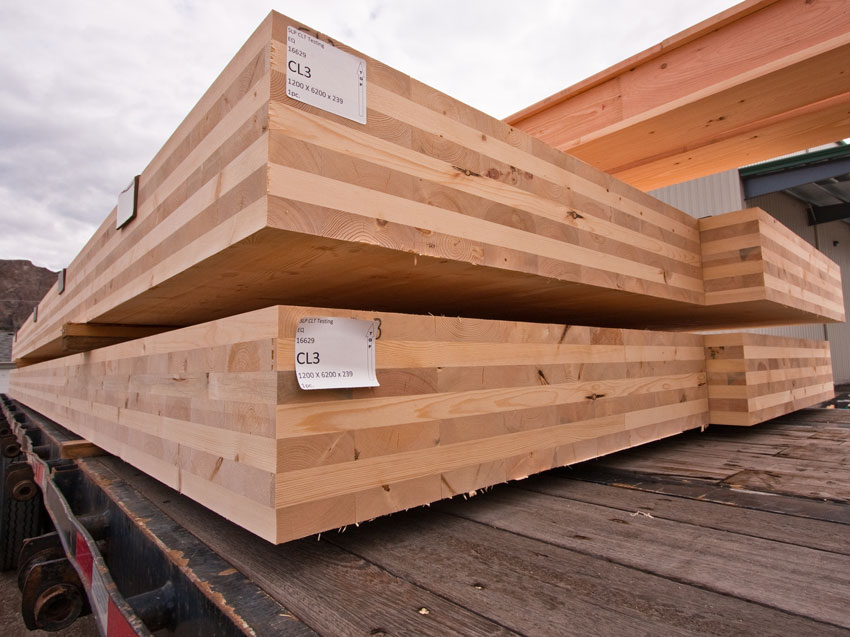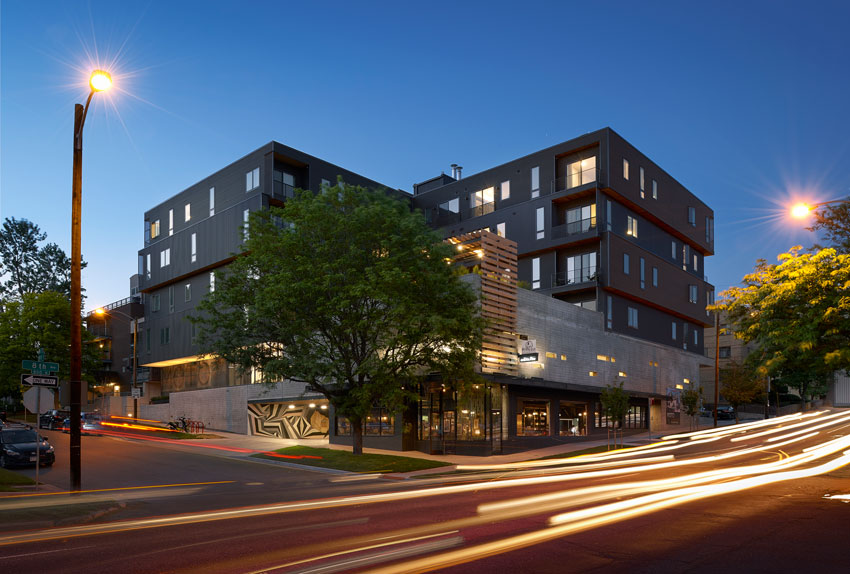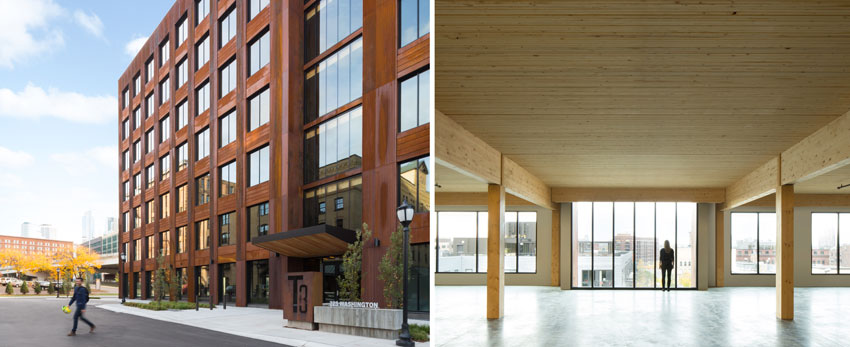Structural Wood Building Systems
Description of a Mass-Timber System
Mass timber is a category of framing styles typically characterized by the use of large solid-wood panels for wall, floor, and roof construction. Building with mass timber offers a reduced carbon footprint, construction efficiency, fire and life safety, and occupant well-being. We will discuss these performance benefits in more detail later in the course, but let’s first review the primary types of mass-timber construction.
Glulam
Glue-laminated timber (glulam) is a structural engineered wood element commonly used for beams and columns in residential and commercial applications. To form a glulam component, dimension lumber wood laminations are positioned according to their stress-rated performance characteristics. In most cases, the strongest laminations sandwich the beam in order to absorb stress proportionally and ensure the member’s longevity. The laminations are jointed end to end, allowing for long spans, and are bonded with a durable, moisture-resistant adhesive. The laminations’ grains run parallel with the member’s length to improve its strength.
Glulam is stronger than steel at comparable weights, and it is stronger and stiffer than dimension lumber, according to APA – The Engineered Wood Association. That makes the material a cost-effective choice for long, structural spans and tall columns with minimal need for additional support. Glulam is a highly visible form of mass timber in contemporary projects, with long spans framing signature designs that have been left exposed to take advantage of wood’s natural aesthetic. Glulam can be used in interior and exterior applications, as several manufacturers sell glulam products with adhesives that can withstand moisture and wear from use outdoors.
NLT
Nail-laminated timber (NLT or nail-lam) is a century-old construction method that is undergoing a design renaissance. It can be found today in many historical buildings as well as compelling new projects of all sizes, where its structural performance and design elegance come together to create inspiring spaces.
NLT gets its strength and durability from the nails that fasten individual dimension lumber, stacked on edge into a single structural element. Applications for NLT include flooring, decking, roofing, and walls as well as elevator and stair shafts. Because NLT is made of wood, it offers a consistent and attractive appearance for decorative or exposed-to-view applications.

Photo courtesy of Think Wood
NLT gets its strength and durability from the nails that fasten individual dimension lumber, stacked on edge, into a single structural element.
CLT
Cross-laminated timber (CLT) is a relatively new structural engineered wood-panel system that is gaining popularity in the United States after being widely adopted in Europe. CLT panels are made of layers of lumber boards (usually three, five, or seven) stacked crosswise at 90-degree angles and glued into place. The panels can be manufactured at custom dimensions, though transportation restrictions dictate their length.
Applications for CLT include floors, walls, and roofing. The panels’ ability to resist high racking and compressive forces makes them especially cost-effective for multistory and long-span diaphragm applications. CLT is the basis of the tall wood movement, as the material’s high strength, dimensional stability, and rigidity allow it to be used in mid- and high-rise construction.

Photo courtesy of Structurlam
CLT is the basis of the tall-wood movement, as the material’s high strength, dimensional stability, and rigidity allow it to be used in mid- and high-rise construction.
DLT
Dowel-laminated timber (DLT) is common in Europe and is gaining traction in the United States for its ease of use with computer-controlled (CNC) machinery, such as lathes, routers, and mills, and its all-wood composition. DLT is similar to NLT, but instead of nails or screws, DLT uses wood dowels to join laminations. To form DLT members, softwood lumber panels are stacked like NLT and are friction fit together with hardwood dowels. Friction fit, achieved by the differing moisture content of the softwood panels and the hardwood dowels, affords additional dimensional stability. The dowels can be inserted diagonally, offering additional resistance. Because DLT does not use nails or screws, it is easier and safer to mill and route, and the lack of an adhesive is also attractive for projects looking to maximize the use of wood.
In application, DLT performs similarly to glulam and NLT. Because its grains run in one direction, DLT is a next-generation mass-timber product that allows for significant architectural flexibility and is well-suited for horizontal spans, such as flooring and roofing applications.

Photo courtesy of Ryan Gobuty
MOTO | Gensler
Buildings with wood podiums have a lower mass, meaning less material is needed for the foundation and shear walls. Consistent structural material use throughout the building also reduces the need for different trades on-site, streamlining labor costs and construction timelines.











